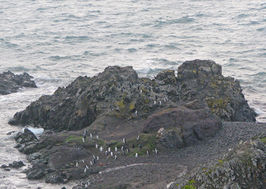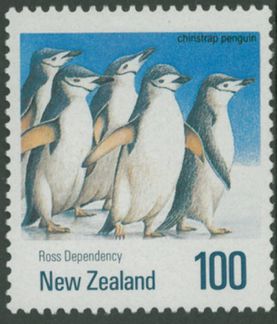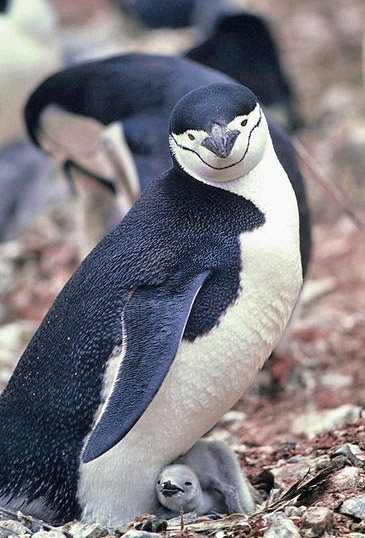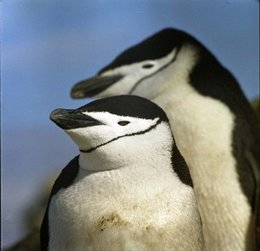Chinstrap penguin
| Conservation Status |
|
Scientific Classification Kingdom: Animalia |
Also called Stone cracker penguin, the Chinstap penguin (scientific name: Pygoscelis antarcticus) is one of seventeen species of flightless birds in the family of penguins. It is one of three Brush-tailed Penguins in the genus Pygoscelis, which also includes the Adelie and the Gentoo penguins. The Chinstrap penguin derives its name from a distinctive line along the lower portion of its head.
Like all penguins, the Chinstrap penguin is characterised by its erect posture, stiff wings (flippers), excellent swimming ability, awkward movement out of water and bold plumage colouration. The black back and white front, make penguins difficult to see when swimming, blending against the sea from above and the sky from below.
The Chinstrap penguin is easily identified by the narrow black band on its plumage just below the chin, rendering the bird's appearance like a marching bird with a cap with strap. The species architecture is built to withstand extreme cold, using densely packed feathers and a layer of blubber. Distributed over parts of the Southern Ocean, the Chinstrap penguin is one of fewspecies that is abundant and expanding, but may be an indicator of other imbalances in their ecosystem, since they are beneficiaries of whale species decline in the Southern Ocean.
Contents
Physical description
Chinstrap penguins are white on the front and throat but have a black back. A thin band of black plumage runs from one side of the head to the other, right below each reddish eye and unites under the bill. Chicks have gray backs and white fronts. The male and female Chinstraps appear the same (monomorphic), thus making it hard to tell them apart without non-morphological cues. They stand approximately 72 centimeters tall and have a body mass of approximately about 3.5 to 5.0 kilograms. Adult weight varies during the year. When the penguin is in the molting season, an individual typically gains the most weight, and when they are in the brooding period they lose the most. Chinstrap penguins are able to withstand extreme cold due to the insulation provided by their short, densely packed feathers, which in turn form a waterproof coat. Underneath these feathers, a thick layer of fat or blubber also serves as storage for energy. These adaptations help protect them against the extreme cold conditions of the Antarctic by minimizing heat loss in icy cold waters.
Behavior
Penguins in general communicate through complex ritual behaviors that include head and flipper waving, calling, bowing, gesturing and preening. Stares, pointing and even charging occur when the Chinstraps have territorial disputes. During courtship and mating rituals the male Chinstrap penguin communicates through pumping his chest several times and stretching his head upward. He then emits a harsh loud screeching sound and is soon joined in by other penguins, thus create a mass trumpeting. This is believed to help synchronize the breeding cycle. Chinstrap penguins live and breed in large colonies and dive off their iceberg homes to catch fish and krill. The Chinstrap is considered the boldest penguin and thus is the most likely to fight other penguins. Lastly, they are recognized and sometimes called "Stone cracker Penguins" because of their high-pitched call.
Their principal predator is the leopard seal, while the main predators of eggs and chicks are the Sheathbilland Brown skua. They are not considered to be migratory.
Reproduction
hinstrap penguin breeding colonies are quite freqently expansive, with over 100,000 breeding pairs congregating at certain sites Each male female pair forms a close bond, with monogamy persisting from year to year; moreover, the pair will often utilize the identical nesting site in successive years. In late November, at the onset of the Austral summer, the female characteristically deposits two eggs in a a circular platform nest with a shallow nest cup interior. The nests are roughly typically 40 cm in diameter and up to 15 cm high. Female Chinstrap penguins usually lay eggs two to four weeks later than other Brush-tailed penguin species in a given locale. Each of the pair participate incubation work, in shifts of five to ten days; after 33 to 35 days the chicks hatch. The parental cooperation extends to subsequent shared supervision of the young hatchlings.
In sharp contrast with parental philosophy of other penguins, the Chinstrap adults do not give preferential treatment to stronger offspring, but nurture both chicks equivalently. Fledging typically occurs at age seven to eight weeks. Eventually the chicks congregate with peers to form crèches (groups of young penguins huddling together for warmth and protection). At 50 to 60 days of age, and after moulting, the chicks finally venture into the ocean. The breeding cycle is usually completed by February or March, and the species typically returns to the pack ice during Austral winter. Breeding success is quite variable from year to year, with considerably higher chick mortality in years when sea-ice persists near the colonies, restricting sea-access for foraging adults.
Distribution
The Chinstrap penguin inhabits the sub-Antarctic including the Antarctic Peninsula, with the preponderance found within the Southern Ocean. Chinstrap penguins specifically breed on the Antarctic Peninsula and the coastal islands of the continent. Chiefly, they are found on the South Shetland Islands, South Orkney Islands and South Sandwich Islands as well as smaller islands such as King George Island, and also on very small islands such as Ardley Island off of King George Island, part of the Antarctic Peninsula. Principal seas of these breeding grounds are the Amundsen Sea and Bellinghausen Sea. Besides the breeding colonies on the Antarctic Peninsula and on sub-Antarctic islands there is also a small breeding population on the Balleny Islands (Including Buckle Island, Chinstrap Islet and Sabrina Islet), south of New Zealand and on Bouvet Island (controlled by Norway).
Habitat
 Chinstrap colony at rocky outcrop of King George Island,
Chinstrap colony at rocky outcrop of King George Island,
Antarctica. Source: C.Michael Hogan Chinstrap Penguins are often found on rocky shorelines along the Antarctic Peninsula as well as the islands to its north. Chinstrap Penguins often live on large icebergs on the open ocean. One large stable colony on the South Sandwich Islands were last estimated to include about 7.5 million breeding pairs. The species as a whole are considered a stable and even growing population and were last estimated to include about 7.5 million breeding pairs. Due to the extreme southerly latitudes there is a paucity of plantlife, other than a panoply of mosses, lichens and certain other low growing species.
Evolution
A common ancestor of all penguin and albatross species has been postulated to have existed in Gondwana approximately 71 million years ago (Mya), when Australia, Antarctica and South America were attached. (Baker et al. 2006) Common ancestry to all extant penguin genera was deduced to have existed at approximately 39 to 41 Mya. These timelines were established by DNA molecularsequencing studies, but are also supported by fossil evidence. Appearance of the genus Pygoscelis occurred considerably before present, with breeding colonies at least as early as the Pleistocene in the far north as New Zealand, due to the warmer weather of that era. The species within the genus have evolved during several climate oscillations involving glacial advance and retreat, leading to species adaptability to climate change; in fact, Chinstrap populations have benefitted in the most recent century by a slight warming of the Antarctic Zone. A common ancestor to all the penguin species is suggested as late as 40 Mya, when genus Pygoscelis diverged as the basal lineage; moreover, while the common ancestor for genus Pygoscelis is evidenced at 20 Mya based upon genomic sequencing; furthermore, the Chinstrap and Gentoo penguins , which are closely related within the genus, have a suggested common ancestor at around 15 Mya.
Feeding habits
The Chinstrap's diet is quite simple and consists of small shoaling animals: krill, small fish and other roaming marine crustacea. Chinstrap penguins' prey is 95 percent krill and about five percent of other species mentioned.
Conservation status
 New Zealand stamp commemorating the Chinstrap penguin. 12 to 13 million Chinstrap penguins are thought to be located on the barren islands of the sub-Antarctic Region and the Antarctic Peninsula. Thus, this species is in no immediate danger. They are legally protected from hunting and egg collecting.
New Zealand stamp commemorating the Chinstrap penguin. 12 to 13 million Chinstrap penguins are thought to be located on the barren islands of the sub-Antarctic Region and the Antarctic Peninsula. Thus, this species is in no immediate danger. They are legally protected from hunting and egg collecting.
Two recent studies show that penguins have been infected with diseases that were most likely spread by people discarding poultry. Australian scientists at Mawson Station in Antartica found antibodies for infectious bursal disease virus (IBDV) in Emperor penguin chicks (Aptenodytes forsteri) and adults of Pygoscelis adeliae), Adelie penguins. Swedish scientists found Salmonella bacteria in penguins on Bird Island.
Under the Antarctic Treaty System, the "Agreed Measures for the Conservation of Antarctic Fauna and Flora prohibit killing, wounding, capturing, or molesting any native mammal or bird in [[Antarctic]a] without a permit." These "Agreed Measures" strengthen the conservation by the Protocol on Environmental Protection for the Antarctic Treaty. Annex II. This protocol prohibits the import of live poultry, and requires specific treatment for dressed poultry and its disposal. To evaluate the statues of various animals the the Conservation Assessment and Management Plan (CAMP) is used, which determines the conservation priorities for a country. During a conference in 1992 where New Zealand penguins were discussed resulted in the choices of further management, research and captive breeding programs for nine species and subspecies.
Economic importance for humans
Penguins in general are a significant tourist attraction within a wide ranging region of the Southern Hemisphere. In the past, commercial egg collecting caused severe damage to rookeries, and penguins were also slaughtered for their blubber. In some places, such as islands in the southern Indian Ocean, fishermen still use meat from some penguin species for fishing bait. Of the larger species of seafood that the Chinstrap comsumes approximately 94 percent are fish, five percent squid, and one percent crustacea, although krill comprises the bulk of caloric intake, as discussed above. Fisheries argue that in one breeding season, all species of penguin are able to eat 7000 tons of food, and 2900 of that has economic value to humans. Thetotal economic value of the species is far greater than any imputed current economic benefit; in addressing the total economic benefit one considers the Existence benefit (value placed on the species for scientific and recreational observation and for human willingness to preserve the species) as well as the legacy benefit, or that value for future generations in supplying enjoyment as well as genetic resources which can prove valuable in scientific research and pharmaceutical sources.
References
- T.D.Williams. 1995. Bird Families of the World: The Penguins. Oxford University Press, Oxford.
- Encyclopedia of Life. 2009. Pygoscelis antarcticus (J. R. Forster, 1781) (accessed March 11, 2009)
- Pygoscelis antarcticus (J. R. Forster, 1781) Species 2000 & ITIS Catalogue of Life: 2009 Annual Checklist, Reading, UK.
- ARKive. 2010. Pygoscelis antarcticus: Fact and status sheet
- World Registry of Marine Species. 2006. WoRMS taxon data for Pygoscelis antarcticus
- International Union for Conservation of Nature and Natural Resources. 2010.IUCN Red List: Pygoscelis antarcticus (Accessed August 25, 2010)
- Birdlife International. 2003. Pygoscelis antarcticus (Accessed August 25, 2010)
- A.J.Baker, S.L.Pereira, O.P.Haddrath and K.A.Edge. 2006. Multiple gene evidence for expansion of extant penguins out of Antarctica due to global cooling. Proc Biol Sci. vol. 273, issue 1582, pp. 11–17
- M.Coulson. 2001. Chinstrap penguin. Animal Diversity Web (Accessed August 25, 2010)


